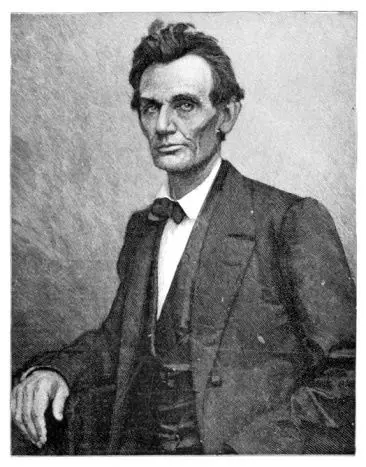Abraham Lincoln (1809-1865)

President from 1861-1865
By Kate Kelly, AmericaComesAlive.com
When we learn about Abraham Lincoln’s childhood, it is difficult to believe that this man grew up to become a great orator and a strong and principled leader of our country who guided our nation through its darkest time.
Abraham Lincoln was born in Kentucky in 1809. He and his sister Sarah (known as Sally) were born to Nancy Hanks and Tom Lincoln. Tom was an uneducated but relatively prosperous Kentucky farmer, but as more people made their way into Kentucky, Lincoln found that the laws did not protect him from people who were out to poach his land. He became angry and frustrated and soon moved his young family to Perry County, Indiana.
The area where they settled was largely unsettled (an average of 3 people per square mile), and the land was untamed. Abe Lincoln later described life in this area known as Little Pigeon Creek as a fight “with trees and logs and grubs.” While the family worked hard at farming, Tom had to rely on hunting most days to feed his family. Tom eventually built a one-room cabin for the family, but there was no flooring and little furniture. The family slept on corn husk beds that frequently were inhabited by bugs and visited by rodents.
Their mother, Nancy, was very religious and taught the children about the Bible, and she believed in the importance of education. However, schools were uncommon in these lightly populated areas. When Abe was about seven, a school opened nine miles away, and Nancy insisted to Tom that the children be allowed to attend. (At best, the walk to school would have taken the children 2.5-3 hours each way, so it was a major commitment.) The school did not last long. However, the importance of education was impressed upon Abe’s mind.
When Abe was nine (1818), Nancy became very ill with “milk sickness.” This was an illness we don’t hear about anymore, but several of their neighbors had already died from it. Today scientists know that if cows ingest a plant known as white snakeroot, it goes through to their milk, and some people become sick and die from it.
Nancy’s death left Sally and Abe in the sole care of their father, who was overwhelmed by the need to hunt daily and still to try to cultivate the land so they could grow some food. Historians report that he was a tough man who was known to knock his son down in anger at times; whether he would have been viewed as abusive or whether he was a “man of his day” is debated by experts.
The children were heartbroken at losing their mother, and the house was a mess without Nancy to bring order to it. Tom realized he needed help, so he left nine-year-old Abe and Eleven-year-old Sally alone in the cabin while he returned to Kentucky to find a new wife. The children had little to eat other than dried berries that had been stored away by Nancy. A neighbor who stopped by reported that the children were terribly skinny, filthy and the house was in terrible condition.
Abe and Sally were alone for half of the following year. They must have been certain they had been abandoned. However, six months later, Tom pulled up in a horse-drawn wagon with a new wife and her three children. Abe was said to have run to this new mother whom he had never met and immediately bury his face in her skirts.
Abe’s blind faith in her was well-placed. Sarah Bush Johnston was a loving person whose first order of business was getting her new husband to make household improvements including a wooden floor as well as a wooden door and a window. She was even-handed in her treatment of Abe and Sally and her three children. Though she could not read, she heard from Tom about Abe’s efforts to read, and she brought with her six books. Among them were Pilgrim’s Progress, Parson Weem’s Life of Washington (which is now recognized for the myths it told about our first president), and Aesop’s Fables. Though the family had little money for paper, pencils or books, Sarah did what she could to get a few things so Abe could study.
Another opportunity for the children to attend school occurred after Sarah arrived, and she, too, saw the importance of it. The school was only a mile away, but it only lasted for three months.
Lincoln had grown tall and vigorous, and as was customary in that day, a son under legal age was obligated to give any earnings to his father. Tom profited by hiring Abe out to help other farmers or business people. Lincoln did a bit of traveling in working for others. Finally, at the age of 22, Abe packed his few belongings and moved to New Salem, Illinois.
While Abe apparently loved the women who had raised him, there is little doubt that there was no love for his father. Reporters frequently sought information about his family background, but Lincoln rarely talked about it, not mentioning his father at all. When Tom Lincoln died in 1851, Abe did not attend the funeral.
These stories of a few of our presidents are just a few of the little-known stories available at Kate Kelly’s website www.americacomesalive.com In February (Black History Month) and March (Women’s History Month), Kate will be profiling many leaders from backgrounds that up until recently could not have led to the White House. To be added to either list, please visit the website. Don’t miss Growing Up to Be President: Theodore Roosevelt.
